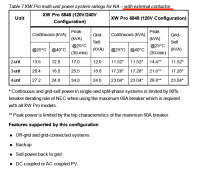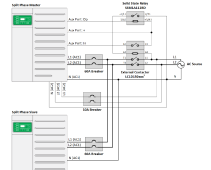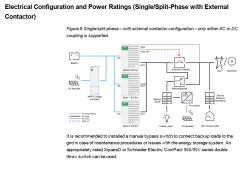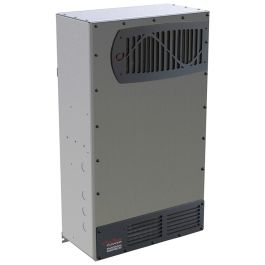First, if you have two inverters, and your potential load was more than 60 Amps, couldn't they have the same problem? Couldn't the relays still try to carry the current in an unbalanced way creating the same overload/welding failure?
Second, if I am only planning on using the Grid for emergency battery charging, is it possible to set up the XW Pro so it never attempts to power the backup loads panel through the Grid? If this is possible, there should never be relay switching from PV to Grid and back.
1. Answer to first Q. Probably not. A relay's continuous current rating is X, its breaking current rating is typically 2-5X (depends on manufacture datasheet). So assuming you had 2 XW's, operating in AC passthrough of 120A load (60A each), had a grid down scenario, both XW relays open, inverter would output a max of 104A (52A Each) and loads would not drop, this is 100% acceptable per the Schneider manual. It is an allowed configuration per their multi unit specs/manual.
2. Answer to second Q. Yes, but not how you explained. The inverter is bidirectional to/from all energy sources. This is the hard part to understand. See the picture below of the functional power block (user manual pages 24-26). If at any time AC1 OR AC2 relays are closed, it CAN power the loads based upon the operational modes programed. To answer your question fully, the XW can operate in "Grid Support" mode (user manual pages 80-83) and if properly configured, can provide exactly what you want (only use AC to keep batteries up and to not power loads directly). Understand, it could only do this based upon parameter settings and there will be some AC grid current at all times no matter what, a few watts best case scenario.
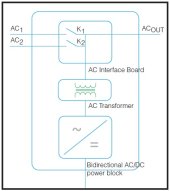
Understand, the XW allows unlimited configurations due to the many parameters. Most people/installers get them set incorrectly and the units behave incorrectly, and they get a bad name/reviews/bashing. The XW is really an engineers wet dream, not a DIY 1 button configuration. I am not partial to either XW or Radian. I believe the XW to be a better product due to the ecosystem of accessories and level of integration. Not to mention it is Schneider electric which is not going anywhere. The Con is you pay for it $$$. The Outback Radian solution is equally comparable. In my eyes, their ecosystem/software is not as polished, but offers higher total output KW, but less surge KW/to full KW ratios as the XW. Both are LF inverters, the top of the food chain from each, and both are winners. As an EE, with OCD, I find the minor differences between the two.
In regard to the 3 or more unit requiring external relays. Schneider has taken the upfront, visible analytical approach as said, if 3 or more XW's used, the probability of failure has risen due to the reduction of lifespan, which increases liability due to welding failure, reduces lifespan of the relay/inverter, increases warranty cost, and carries risk associated to UL listings/possible back feed, and therefore we suggest using an external contactor. Understand no company who makes relays for a living is going to say that it is ok to operate outside its datasheet specifications. The datasheet has specs for everything, including lifespan. The XW is an old design, from Xantrex, carried over to Schneider. The market really needs 200A internal bypass ratings like the Sol-Ark 15K, but minus the other firmware/HF inverter headaches, I digress.
What you/everyone is missing is that Radian has an identical limitation, but goes unnoticed. Per the Radian installation manual, when using 2 or more (up to 10), you cannot enable Grid Support or Grid Zero modes. These modes would close the internal transfer relay all the time, and it would be subjected to the same exact scenario as the XW that I have described previously. Radian does not come out and tell you "NO! Don't do it" like XW, they bury the comment in the installation manual, that is a tiny footnote, that references the user manual. XW clearly calls it out and says NO. The exact reason why Radian says no to these 2 modes of operation is exactly the reason XW says you cannot do 3 or more units in parallel without an external bypass contactor. It is Radian marketing of saying "look, we can do 10 in parallel!". Both inverters are subject to the same restriction, yet one manufacture is up front about it. Read page 41 Important footnote of the radian installation manual.
"Do not use the AC input modes Support or Grid Zero in a stacked system. See the Operator’s Manual."
FYI, I am not affiliated with NOR rep either brands. I simply provide custom solutions that work.



